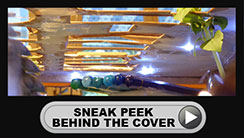
We have all heard of the importance of learning CPR (Cardiopulmonary Resuscitation) - we see it in the movies, we read of amazing success stories in the news, a lot of us have even been on a course years ago. But somehow it can be just a bit too scary to think about - anxiety, fear of facing such an emotional subject or just that life gets too busy with other things.
Sometimes reading the objective scientific evidence and gaining an overall view of exactly what happens when a person's life is saved, can dissolve the anxiety and result in determination to understand more. Read on....
What is the significance of those five red circles in the photo above? This is the 'Chain of Survival' - created by Mary Newman, president of the Sudden Cardiac Arrest Foundation, who published this concept in the Journal of Emergency Medical Services in 1989. The Swiss Resuscitation Council recommend the use of this metaphor to visually demonstrate just how people who have heart attacks can be saved.
- The first link is the recognition that someone's heart has stopped and to call the emergency services (144 or 112).
- The second link is starting Cardiopulmonary Resuscitation (CPR) as quickly as possible. This can be with chest compressions only instead of the traditional rescue breaths alternating with chest compressions (there is new evidence to show how effective compression-only CPR is!)
- The third link is using a defibrillator to try to restart the person's heart. These are in one of those red or green boxes that you might have seen in airports, shopping centres, sports centres, work places etc. Anyone can use them!
- The fourth link is the advanced medical care that paramedics, doctors, nurses arriving at the scene can give - oxygen, medications, fluids and more.
- The final link is the expert treatment that the person will receive in the hospital once their heart is beating again.
As with any chain, it is only as strong as its weakest link. What do you think the weakest link is....? It is link number one. Do you know how to recognise whether someone's heart has stopped? What do they look like? What sounds might they make?
The next weakest link is the second one - the fast starting of good CPR by you - the bystander. If you know how to do this (and it is easy to learn and practice) then you will significantly increase the chance of your friend, family member or other person surviving and leaving hospital alive! In the studies referenced below, it was discovered that someone who was given CPR from the emergency services only, once the ambulance had travelled to the scene, had a 22% chance of survival. But those who had received CPR from bystanders had a 43% chance of survival - a remarkable increase.
One of the most important reasons for this is that during CPR you are pumping their blood around their body and supplying the brain with oxygen, glucose and other important chemicals. The brain cells are kept more alive and therefore so does the person.
We all know that we should be trained in CPR. Be a strong, not weak, link in this chain and help someone leave hospital smiling and ready to go. Resolve to get trained this Autumn!
Author's bio
 Dr Penny Fraser MB BS BSc(HONS) MRCS(ENG)
Dr Penny Fraser MB BS BSc(HONS) MRCS(ENG)
Dr Penny is a British-trained Emergency Medicine doctor, who lives in Geneva. She is also the mother of two busy little skiers aged 7 and 9. Along with Dr Michelle Wright and her other colleagues at HealthFirst, she has a passion for delivering health education and First Aid training to the English-speaking community in Switzerland.
HealthFirst provides a range of practical, interactive First Aid courses including a unique Mountain First Aid Course and a First Aid course, obligatory for the Swiss Driver’s Licence, and suitable for anyone from the age of 14.









